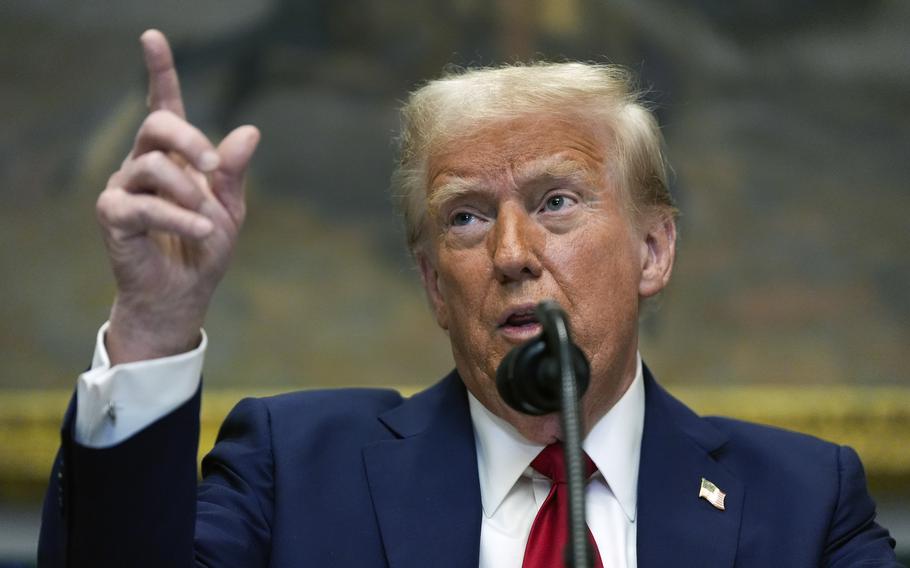
President Donald Trump speaks Tuesday, Jan. 21, 2025, in the Roosevelt Room of the White House. (Julia Demaree Nikhinson/AP)
President Donald Trump on Thursday said all NATO countries must sharply increase their defense spending, demanding member states push well beyond current benchmarks that many of them already struggle to hit.
Trump, speaking to an audience of global leaders gathered at an economic forum in Davos, Switzerland, said the current NATO threshold that calls for spending 2% of gross domestic product on military matters is insufficient.
“I’m also going to ask all NATO nations to increase defense spending to 5% of GDP, which is what it should have been years ago,” Trump said, speaking virtually from Washington.
Trump, who made allied defense spending the focus of his approach to NATO in his first term, said the United States has shouldered too much of the security burden inside the 32-nation bloc. He said the situation has been “unfair” to the United States.
Trump didn’t directly say the 5% standard would apply to the United States. Washington would have to significantly boost its own defense spending to hit the 5% mark. Currently, the U.S. spends about 3.4% of GDP on the defense budget. Going to 5% would push the Pentagon budget of roughly $842 billion to more than $1 trillion.
The focus on defense spending comes amid a wide range of security threats, stretching from the Pacific to Europe and the Middle East.
Among NATO states, defense spending levels have been steadily rising for years. About 20 countries now hit the 2% mark, up from only three in 2014.
Russia’s armed intervention in Ukraine in 2014 followed by its full-scale attack in 2022 have been major factors in the increases. Pressure from Trump during his first term also pushed allies to spend more, alliance officials have acknowledged.
NATO Secretary-General Mark Rutte, speaking in Davos on Thursday, backed Trump’s demands for more spending.
“The problem is not the U.S., the problem is Europe,” said Rutte, who added too many European states are failing to spend the bare minimum on defense.
“That’s problem No. 1,” he said. “Problem No. 2 is that 2% is not nearly enough.”
In the next five years, NATO will be unable to defend itself if spending stays at the 2% level, he said.
In Europe, there is disagreement about the increase to 5%. Poland has backed the idea, and Warsaw has said it expects to hit the higher threshold in 2025. Lithuania has made the same commitment.
But some of NATO’s larger countries have not shown interest in a higher alliance requirement.
Germany, which has been a focal point of Trump’s criticisms over the years, finally hit the 2% level in 2024. But German Chancellor Olaf Scholz has balked at the idea of going much higher.
Canada’s Department of National Defense has said military spending would reach 1.176% of GDP by 2030, though the parliamentary budget office said that estimate was too high.
How Germany manages the defense spending debate with Trump could factor into White House calculations about the future of the American military in Europe. At the end of Trump’s first term, he sought to remove about 12,000 troops from Germany in connection with his complaints about the chronic low levels of domestic spending on defense by successive German governments.